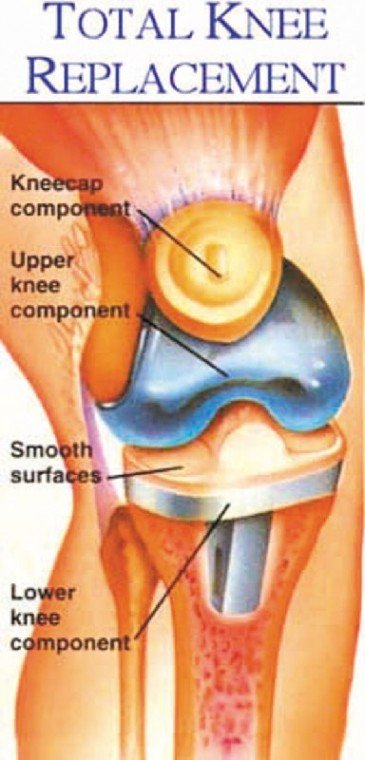Inflammatory diseases like rheumatoid arthritis, osteoarthritis
and gout are more than just painful.
They’re also degenerative forces that can leave sufferers with
serious joint troubles, particularly when the joints affected are
those weight-bearing points, the knees.
Inflammatory diseases like rheumatoid arthritis, osteoarthritis and gout are more than just painful.
They’re also degenerative forces that can leave sufferers with serious joint troubles, particularly when the joints affected are those weight-bearing points, the knees.
These diseases all break down the articular cartilage in the knee, a rubbery covering at the end of the bone that acts as a shock absorber for the leg.
When the cushion is flattened or lost altogether, these shock absorbers cease to function properly and the bones grind against one another instead.
This causes not only pain and swelling, but the formation of bone spurs and a decrease in the range of a knee’s motion, according to the Web site www.arthroscopy.com, a publication of The Center for Orthopedics and Sports Medicine in Marietta, Ga.
Acute pain and grinding discomfort can accompany activities like walking, running and dancing, forcing sufferers to the sidelines.
Many of those symptoms can be alleviated by total knee replacement surgery, but the invasive nature and limited lifespan of the procedure lead doctors to postpone the surgery as long as possible.
“We tell patients that the artificial knee will last about 15 years, though it will probably be longer than that,” said Dr. Frank Bunch, an orthopedic surgeon at Hazel Hawkins Hospital in Hollister who has been performing the surgery since 1982. “You like to do it after 55 because people are generally a bit less active after that, and if they’re doing too much physical activity, the knee may not even last 15 (years). Ideally, you’d like to extend the tolerance.”
When patients first come in to see Bunch, he recommends anti-inflammatories and exercise, since weight loss can play a significant role in making the pain more tolerable and allowing the person to be more mobile.
Patients can also stave off joint replacement with smaller surgeries that take pressure off certain parts of the knee or pain-blocking injections that allow them to move freely despite the continued degeneration of their joints.
For the surgery, doctors cut the length of the knee, open the joint and remove sections of bone from both the thigh and the shin, making room for metal trays that hold plastic bone ends that fit together in a similar fashion to the natural knee. After this is complete, the kneecap is removed and replaced with an artificial button.
“What you’re doing is you’re taking the surfaces that have nerves in them and you’re putting in pieces that don’t have any sensation,” said Bunch. “You can’t feel joint pain in the area after that because there are no nerve endings.”
Patients seen for the procedure at Hazel Hawkins are enrolled in the Total Joint Replacement Program, which allows them to take a tour of the facilities, receive a pre-operative screening and talk extensively with a doctor about what to expect before, during and after surgery.
The potential to develop blood clots is high for the first few weeks after the surgery because of decreased movement, so patients are generally put on anti-coagulants for four to six weeks following surgery.
Doctors wear enclosed hoods to cut down on the spread of germs in surgeries involving bone matter, but patients also receive strong antibiotics for 24 to 48 hours after surgery to help stave off infection.
Post-operative physical activity is almost immediate.
As soon as patients come out of surgery, they’re placed on a machine that moves the knee, and later that night are asked to stand and take a step. Six weeks after surgery, they should be able to walk with a cane, and some don’t even require assistance, said Bunch.
“It all depends on how they’re wired,” said Bunch. “Motivation, tolerance for pain and strength all factor in.”
While activity is often easier after a knee replacement, patients still must be mindful of the fact that an artificial knee is not as sophisticated as the real thing.
Jogging, running or skiing may all be too harsh for the unit, according to arthroscopy.com.
Some doctors will allow patients who previously skied to return to the sport with firm warnings, though, said Bunch.
Post-surgery, the actual motion of the knee will likely be more limited for patients, but the decrease in pain should lead to greater mobility than they’ve enjoyed for some time.
For a more in-depth look at the surgery, visit www.Arthroscopy.com or click on EdHeads.org/
activities/knee.












